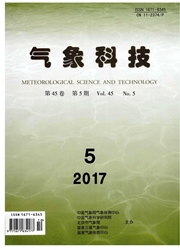

 中文摘要:
中文摘要:
采用基于光谱匹配的计算方法开展红外通道模拟仿真,该方法利用高光谱大气探测仪的实际观测数据来模拟气象卫星成像仪红外通道观测目标亮温。利用高光谱大气探测仪(IASI)的实际观测数据,进行了2010年2月14日12:57(UTC)、2010年2月15日00:57(UTC)、2010年5月2日12:57(UTC)MTSAT-1R卫星成像仪(JA-MI)红外通道的模拟仿真。结果显示:JAMI 4个红外通道的模拟亮温与观测亮温偏差平均值的绝对值都小于1K,模拟亮温与观测亮温的相关系数都大于0.93,表明这种基于高光谱数据的方法可用于气象卫星成像仪红外通道的模拟仿真。进而利用IASI的观测数据进行了2010年11月6个时刻FY-2E卫星成像仪(VISSR)红外通道的模拟仿真,并将通道模拟数据与GSICS定标的观测数据以及与业务定标的观测数据相比,结果表明:2010年11月期间,FY-2E卫星成像仪IR2、IR3、IR4通道的GSICS定标比业务定标有明显的改进。
 英文摘要:
英文摘要:
Using the new channel simulation approach based on spectra matching, by means of the real data from the high-spectral-resolution atmospheric sounder, the brightness temperature in broadband imager IR channels of the observing target is simulated. The real data observed by IASI (Infrared Atmospheric Sounding Interferometer) are used to simulate the IR channels of the Imager (JAMI) of MTSAT-1R at 12:57UTC14 February 2010, 00:57UTC 14 February, 2010, and 12:57UTC 2 May 2010. The results show that the absolute value of the average difference between simulating and observing brightness temperature is less than 1 K for JAMI IRI-IR4, and the correlation coefficient is lager than 0.93. The research shows that the method based on the high spectral-resolution data is effective and can be used in the simulation of meteorological satellite IR channels. Moreover, the real data observed by IASI are used to simulate IR channels of the Imager (VISSR) of FY-2E, and the result shows that GSICS calibration improved greatly, compared with the operational calibration for IR2, IR3, and IR4 in November 2010.
 同期刊论文项目
同期刊论文项目
 同项目期刊论文
同项目期刊论文
 Regression modeling of finite field and anti-electromagnetic design for the ocean surface wind speed
Regression modeling of finite field and anti-electromagnetic design for the ocean surface wind speed 期刊信息
期刊信息
